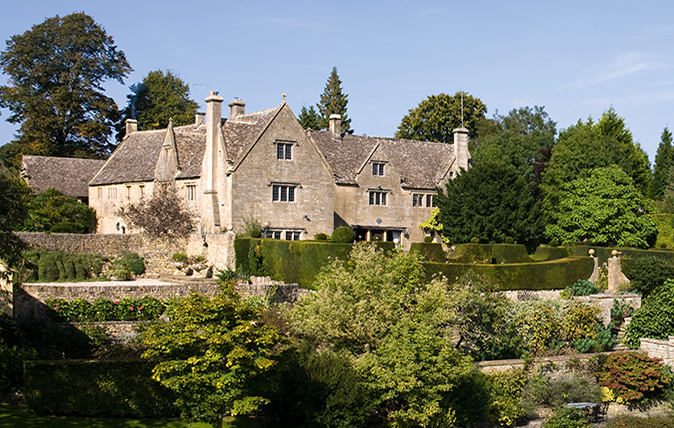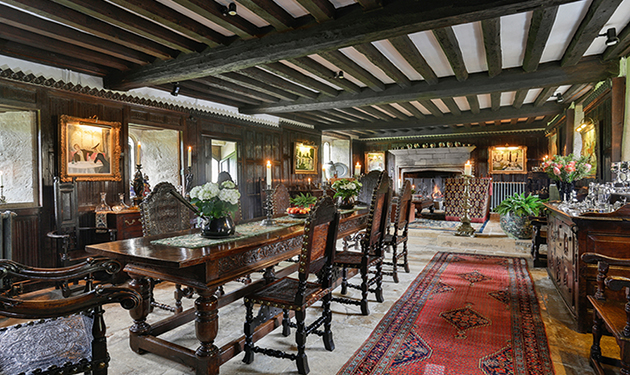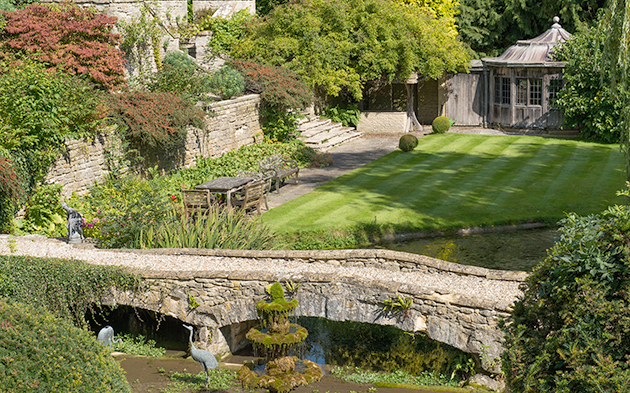A superb Gloucestershire estate
Grade II*-listed Manor Hall at Withington is one of the most prestigious estates to come to the market in some time


A Gloucestershire estate has come to the market fit for a captain of industry
As George W. Bush famously opined: ‘The thing that’s wrong with the French is that they don’t have a word for entrepreneur.’ Well, the English do have a word: Peter de Savary—a restless human tidal wave with the disconcerting ability to simultaneously outline a strategy for a mega-million-pound project and spot a speck of dust at the back of the auditorium from 50 yards.
In a swashbuckling business career spanning more than 50 years, Mr de Savary has, at one time or another, been involved in high-level international operations on three continents, in areas as diverse as the petroleum industry, shipping, shipyards, property, import/export and the club and hospitality industries. During that time, he’s owned and lived in more than 40-odd homes in various parts of the world, from country and waterside houses in Devon and Cornwall to grand mansions in Wiltshire and Somerset, town houses in London, castles in Scotland and France and estates in the Caribbean and the USA.
The house where Mr de Savary has lived the longest is Grade II*-listed Manor Hall at Withington, Gloucestershire, his family home in the heart of the Cotswolds, which he bought in 2000, and which he and his wife, Lana, have transformed from a somewhat eccentrically arranged former Wolsey Lodge complex into a hauntingly lovely, historic country house.

Unlike most previous de Savary houses, which tended to be sold as soon as the magic and excitement of the restoration process had worn off, Manor Hall has retained its place in Mr de Savary’s affections. ‘The reason why I want to sell now’, says Mr de Savary bluntly, ‘is that I’m older than my wife and now that our daughters are grown up with lives of their own, I don’t want to risk leaving her with a house of this size to cope with single-handed at some point in the future. As a result, we’re currently doing up a house in Surrey where we can see the children and grandchildren more often and more easily.’
Consequently, today sees the launch in COUNTRY LIFE of the immaculate, 207-acre Manor Hall estate, as a whole or in three lots, through Knight Frank (01285 659771) and Savills (01285 627550), at a guide price of £7.95 million for the main house, three cottages, gardens, grounds and stabling (55 acres in all); £1m for Amberdale, a recently modernised four-bedroom village house and garden; and £1.5m for the remaining 151 acres of arable and grassland and a range of farm buildings.
Manor Hall dates from three main periods—the 15th, 17th and the early 20th centuries—and it is a testament to the de Savarys’ appreciation of the beauty and ‘capabilities’ of ancient buildings that the house now flows seamlessly from one area to another, with all the main rooms perfectly situated in relation to each other and to the whole—a feat not easily achieved in a house that has evolved over 550 years.
Exquisite houses, the beauty of Nature, and how to get the most from your life, straight to your inbox.

The hall stands high on the hillside on the edge of the village of Withington, surrounded by ancient woodland mentioned in Domesday, one of few large tracts to be found in the central Cotswolds. Withington village has two distinct parts—known as the ‘upper’ and ‘lower’ ends—divided by the River Coln. The upper end mainly comprises four large houses, along with the church and churchyard: the manor house, the former rectory, Withington Court (a pretty Georgian house recently sold by Knight Frank) and, to the south overlooking the river, Manor Hall, known as Halewell Close from the 1920s until 2000, when it was renamed by Mr de Savary.
The original medieval part of the hall is thought to have been built for the lord of the manor, the Bishop of Worcester, and probably dates from after 1476, when the use of the house was reserved for the bishops during their regular journeys throughout their large diocese. Having recovered his estates at the Restoration, Withington remained in the hands of the Bishops of Worcester until 1860, when it passed with their other estates to the Ecclesiastical Commissioners.
In 1926, the Commissioners sold the house and its surrounding land, then known as Bennetts Farm, along with a large part of the manor estate, to Reginald J. Gunther, a railway engineer who had fallen in love with Withington while inspecting the rail networks in the area during the First World War. He had the house enlarged and remodelled in the Arts-and-Crafts manner between 1926 and 1928, renaming it Halewell Close after a nearby spring. Gunther is remembered as a man of strong opinions, who overrode his architect, Leslie Mansfield, on many points of design, although the overall effect was harmonious.

He also commissioned the landscape architect Thomas Mawson to design the spectacular gardens that are such a huge part of Manor Hall’s appeal. The terraces, the sculpted yew hedges and the spring-fed lake were all part of Mawson’s inspirational improvements to the grounds. When Gunther died in 1967, the house was eventually bought by a Mrs Carey-Wilson, who ran it as a Wolsey Lodge guesthouse, before selling it, in turn, to Mr de Savary. Manor Hall is set around a charming enclosed courtyard—an intimate, sheltered space at the heart of the house, which now has several entrances, notably the new atrium hall.
This leads through to the recently created open-plan kitchen/breakfast room, with its double-height ceiling and state-of-the-art equipment. The 16th-century Great Hall is another wonderfully atmospheric space, from where ancient stone steps lead to the magnificent solar, the main drawing room, directly above.

Despite its 12,595sq ft of living space—which includes six reception rooms, a huge master suite, eight further bedrooms with en-suite bathrooms, the new kitchen/breakfast room and the conservatory—Manor Hall is relatively inexpensive to run, thanks to the latest in heating and electrical systems, Mr de Savary reveals.
Everything in the house and garden is designed for ease of maintenance, with much of the land let to local farmers and the neighbouring estate. With three cottages that could be let to provide further income, running costs could be further reduced should a new owner wish to do so, he adds.
On a bright and sunny Cotswolds morning, log fires burn cheerfully in all the main rooms, household silver gleams, furniture and panelling glow —and, it goes without saying, there’s not a speck of dust in sight. ‘Whether there’s 30 people staying or just two of you, this place is always welcoming,’ says the master of Manor Hall. It’s the de Savary way.
** Search more country houses and estates in Gloucestershire

